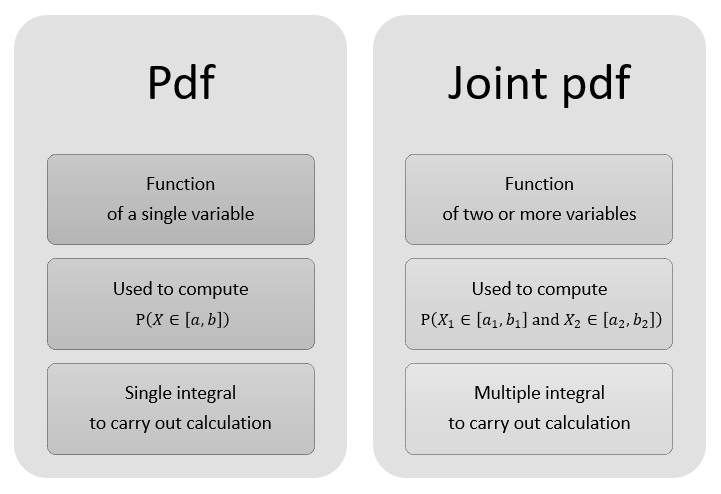The joint probability density function (joint pdf) is a function used to characterize the probability distribution of several continuous random variables, which together form a continuous random vector.
It is a multivariate generalization of the probability density function (pdf), which describes the distribution of a single continuous variable.

The generalization works as follows:
the integral of the density of a continuous variable over an interval is equal to the probability that the variable will belong to that interval;
the multiple integral of the joint density of a continuous vector over a given set is equal to the probability that the random vector will belong to that set.
Do not worry if you do not know how to compute multiple integrals. We will explain them below!
The following is a formal definition.
Definition
Let
be a continuous random vector formed by the random variables
.
The joint probability density function of
is a function
such
that
![[eq3]](/images/joint-probability-density-function__5.png) for
any choice of the
intervals
for
any choice of the
intervals
Note
that![]() is
the probability that the following conditions are
simultaneously satisfied:
is
the probability that the following conditions are
simultaneously satisfied:
the first entry of the vector
belongs to the interval
;
the second entry of the vector
belongs to the interval
;
and so on.
The notation
means that the multiple integral is computed along all the
coordinates (see below for more details).
We often denote the joint pdf
bywhich
is equivalent to
where
are the
entries of the vector
.
Multiple integrals are relatively easy to work out.
Take, for example, a double
integral:where
takes values in the interval
and
in the interval
.
The integral is computed in two steps:
in the first step, we compute the inner
integral![]() which
gives a function of
which
gives a function of
(
disappears because it has been integrated out);
in the second step, we compute the integral of
,
that
is,
![]()
If there are more than two integrals, the procedure is similar: we work out the integrals one by one, starting from the innermost one.
Here are some examples.
Consider the joint pdf of two
variables![[eq18]](/images/joint-probability-density-function__29.png)
In other words, the joint pdf is equal to
if both entries of the vector belong to the interval
and it is equal to
otherwise.
Suppose that we need to compute the probability that both entries will be less
than or equal to
.
This probability can be computed as a double
integral:![[eq19]](/images/joint-probability-density-function__34.png)
Consider two variables having joint probability density
function![[eq20]](/images/joint-probability-density-function__35.png)
Suppose that we want to calculate the probability that
is greater than or equal to
and at the same time
is less than or equal to
.
This can be accomplished as
follows:![[eq21]](/images/joint-probability-density-function__40.png) where
in step
where
in step
we have performed an integration by parts.
One of the entries of a continuous random vector, when considered in isolation, can be described by its probability density function, which is called marginal density.
The joint density can be used to derive the marginal density. How to do this is explained in the glossary entry about the marginal density function.
Joint probability density functions are discussed in more detail in the lecture on Random vectors.
Previous entry: Joint distribution function
Next entry: Joint probability mass function
Please cite as:
Taboga, Marco (2021). "Joint probability density function", Lectures on probability theory and mathematical statistics. Kindle Direct Publishing. Online appendix. https://www.statlect.com/glossary/joint-probability-density-function.
Most of the learning materials found on this website are now available in a traditional textbook format.